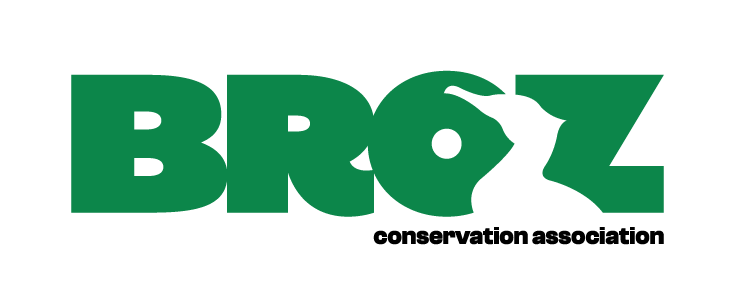We recreate nesting habitats of endangered bird species
Project BeeSandFish is focused on restoration of nesting and feeding habitats of three endangered bird species: European Bee-eater, Kingfisher and Sand Martin. A common feature of the ecology of these species is the use of natural riverbanks and walls for nesting. Project activities are linked with Natura 2000 sites around the rivers Danube and Morava – specifically with SPA Dunajské luhy, Záhorské Pomoravie, Dolné Pohronie, Dolné Považie and Parížske močiare. Implementation of restoration measures as re-establishing a water regime of particular river branches or the whole river branch system of Danube, restoration of vertical riverbanks, wetlands and also reintroducing grazing livestock along the river will create suitable living conditions for these interesting bird species.

Grazing in Bratislava Ružinov (Podunajské Biskupice) continued
Also in 2021, we used our live mowers to maintain habitats in the cadastral area Bratislava Ružinov. We are providing you with some beautiful shots.

The banks in Petržalka were occupied by Sand Martins
The restored steep river bank, which we implemented here in March 2021, has experienced its inhabitants. Gradually, up to 500 pairs of Sand Martins nested here.

Restoration of wetlands near the village Klížska Nemá as a celebration of half a century since the signing of the Ramsar Convention
Every year, on February 2, we celebrate World Wetlands Day. This year, BROZ is celebrating World Wetlands Day with active work on their revitalization - landscaping is currently underway for an extensive renewal of the dynamic water regime of wetlands near the village Klížska Nemá.
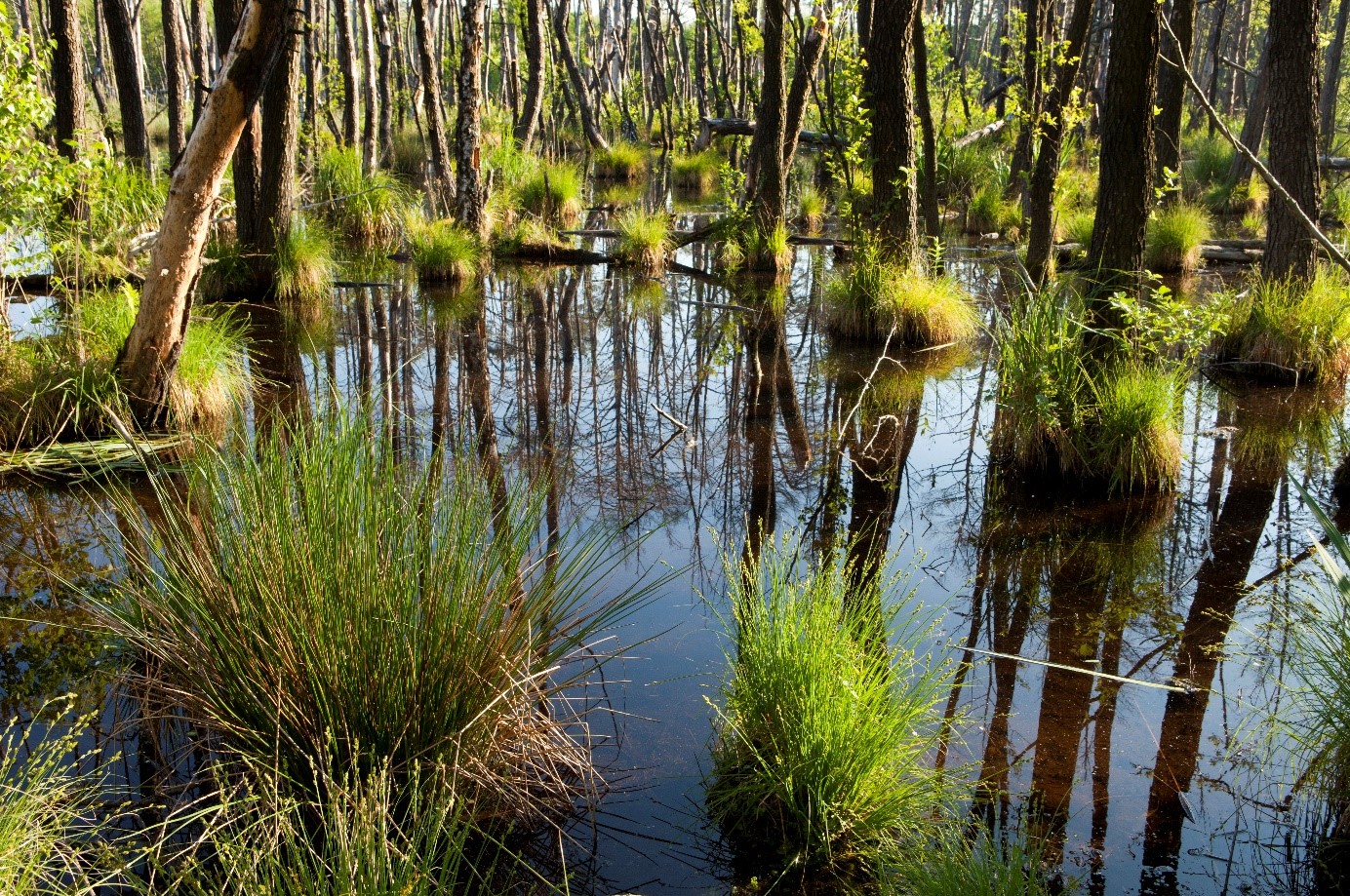

Handover of the construction site in Petržalka – Restoration of steep river banks and nesting walls – Action C.1
The construction site was officially passed to the company, which will carry out revitalization works on the restoration of the steep river bank in Petržalka – Ovsište at the beginning of October.
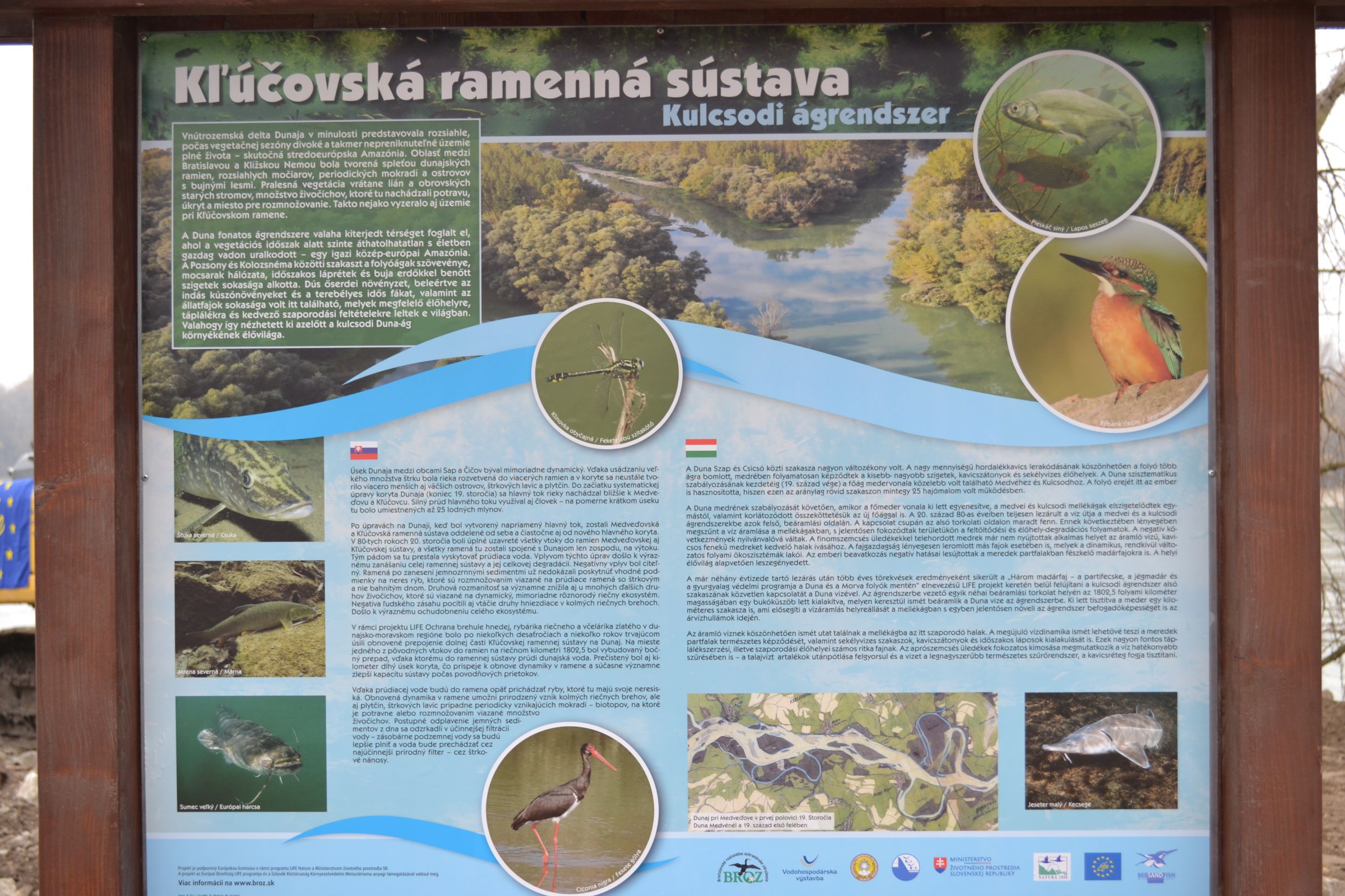
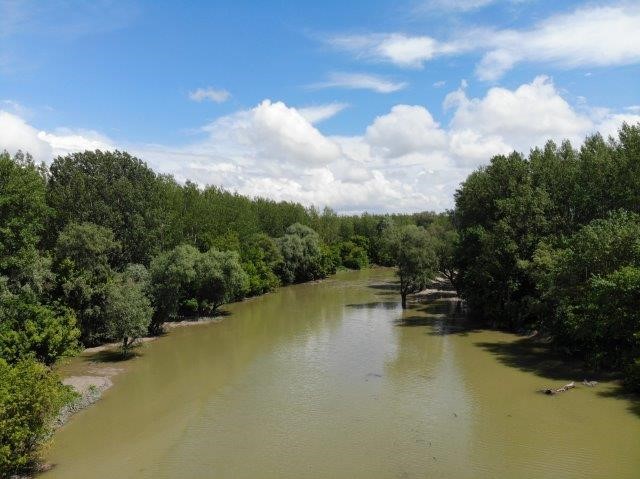

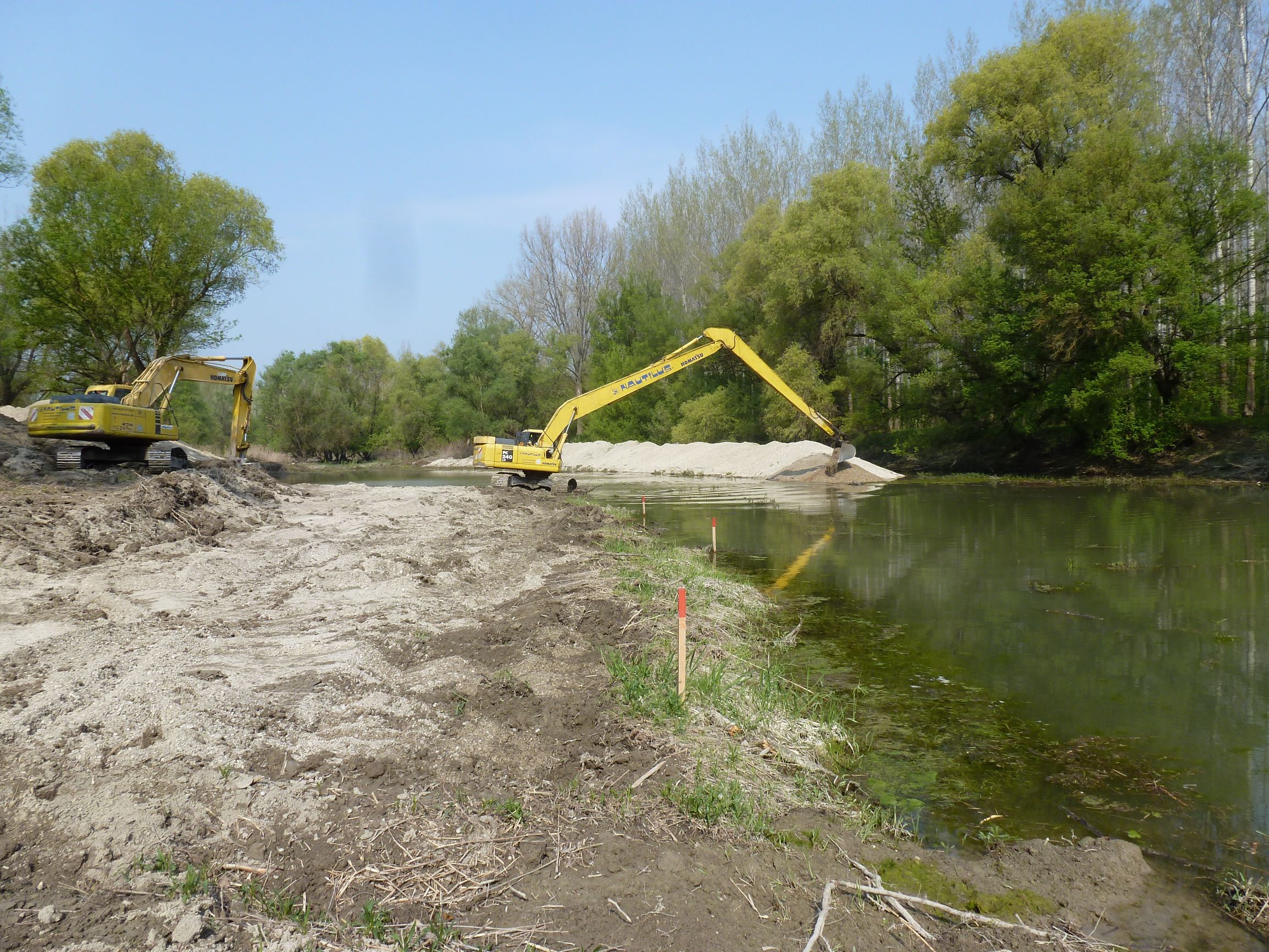
Restoration of the first river branch of river-branch system in Kľúčovec
A lot of work is beeing done at the Danube. Another part of inland Danube delta – the largest river treasure of Slovakia – is going to have flowing water. The works to restore the first river branch of river-branch system in Kľúčovec started in March. Since the middle of the 20th century all inflows into…


Restoration of the food habitats of the target species – grazing in the cadastral area of Radvaň nad Dunajom
The restoration of food habitat by grazing started after several meetings at SPA Dolné Pohronie in the cadastral area Radvaň nad Dunajom, near Virt. An area of 12 hectares was fenced with a new electric fence with a total length of 2000 meters. The battery of fencing is recharged by a solar panel secured by…

Protection and retoration of riparian forest stands and vegetation
The activity started in spring 2016. In spring 2017 tree planting was finalized. We planted the following native tree species: Salix alba, Populus alba, Populus nigra, Alnus glutinosa, Quercus robur, Fraxinus angustifolia in SPA Dunajské Luhy according to the A3 study. The trees were planted in 18 of the originally planned 27 localities. The reason was…

Restoration of steep river banks and nesting walls – Bátorove Kosihy
The restoration of nesting walls in Bátorové Kosihy was prepared and carried out in close cooperation with the local administration office, the mayor and local organization “Brehuľa” (Sand Martin). Information pannels informed the locals about the ongoing works. The nesting locality was used by a colony before the reconstruction, but parts started to overgrow with…

Restoration of steep river banks and nesting walls – Zlatná na Ostrove and Dobrohošť
The habitats were restored by BROZ as part of activity C1 at Zlatná na Ostrove in february 2017 – total length 35m. In Dobrohošť the restoration took place in may 2017 – total length 40m. Both localities are part of the CHVÚ Dunajské Luhy.
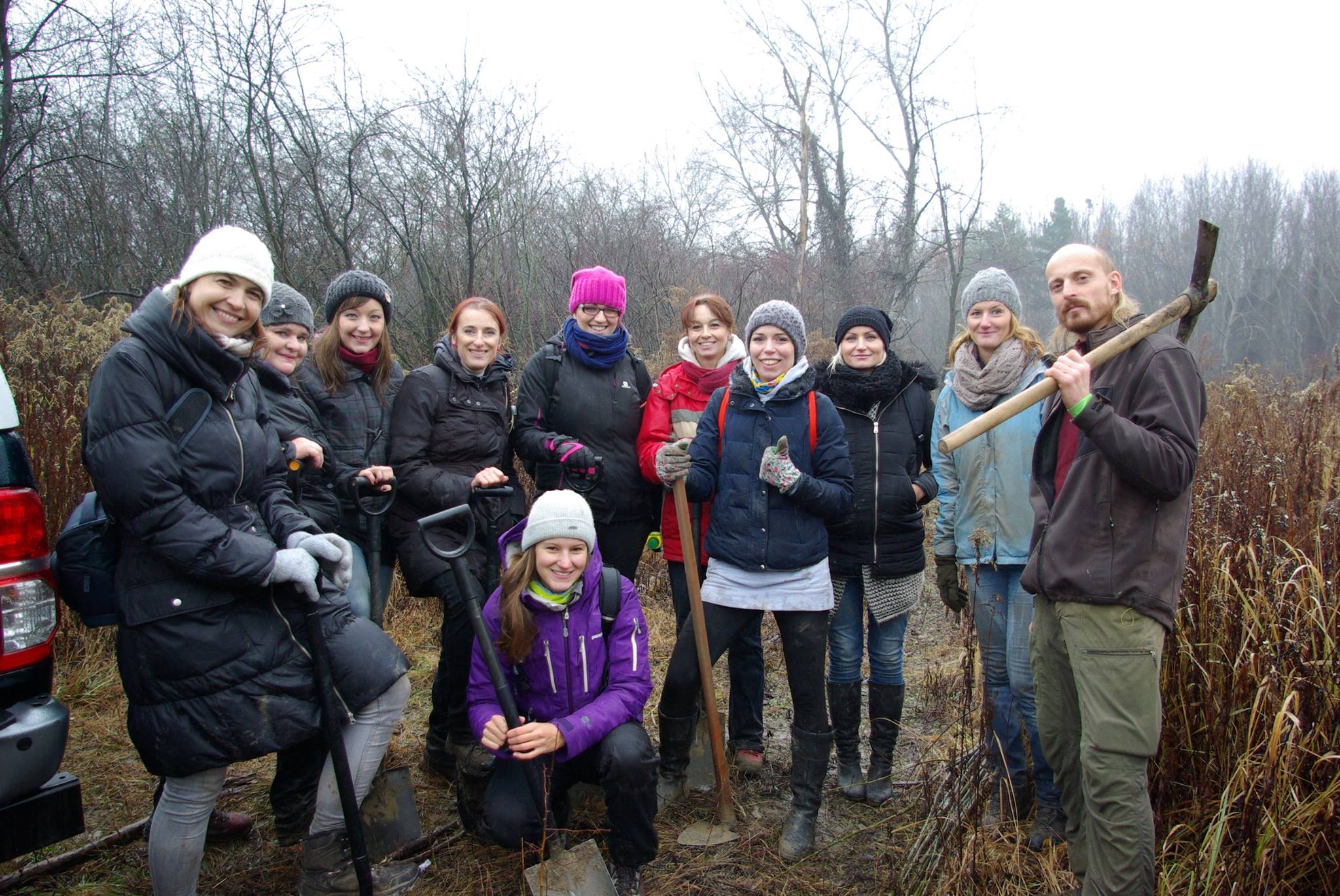

VIDEO from travelling interactive exhibition
Pozrite si video z putovnej interaktívnej výstavy Kolmý riečny breh o živote včelárika zlatého, rybárika riečneho a brehule hnedej.
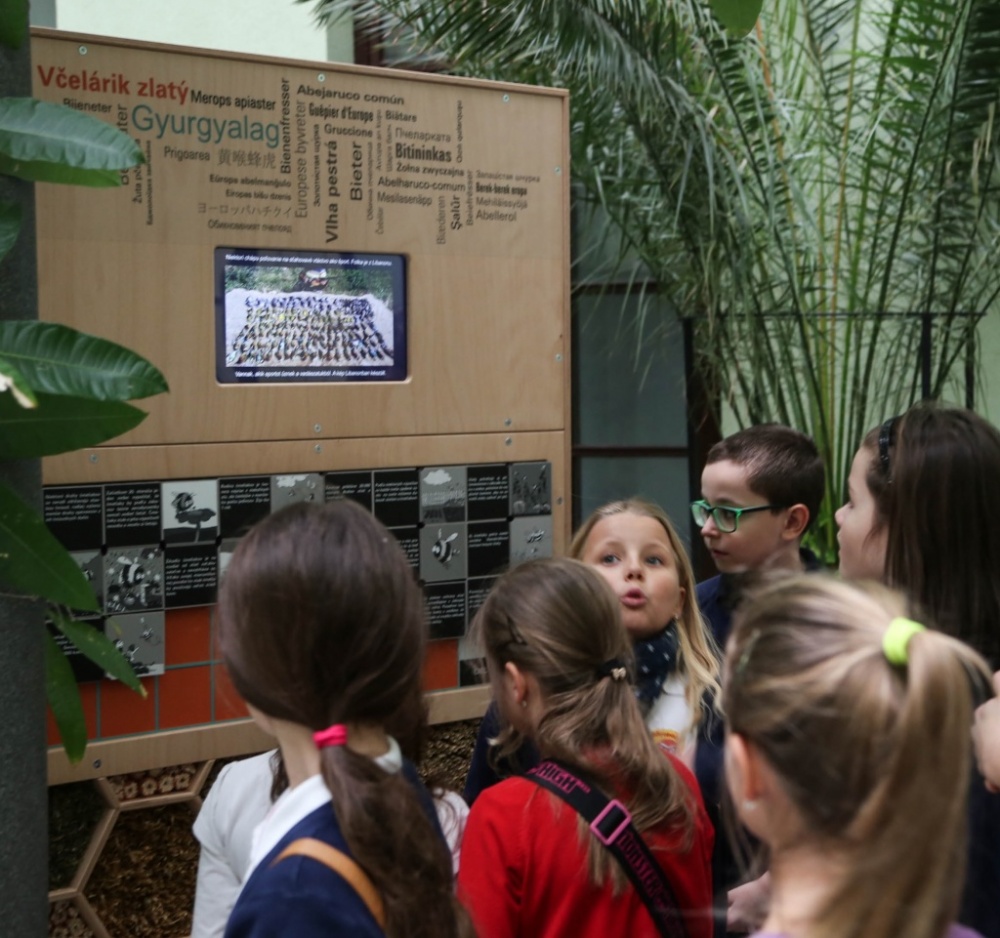
New interactive exhibition for schools
The interactive exhibition for schools about life of Sand Martin, Kingfisher and European Bee-eater is available these days at courthouse Dúbravka-Bratislava till 4.3. – from Monday to Saturday – 16:00 – 19:00 and on Sunday from 10:00 to 13:00. In case you are interested to visit our exhibition as school class (also provided in English),…
Project title: Restoration of nesting and feeding habitats of Sand Martin,
Kingfisher and European Bee-eater in Danube-Morava region
Financial scheme: LIFE+, Nature and Biodiversity
Acronym: LIFE BeeSandFish
Project code: LIFE12 NAT/SK/001137
Budget: 3 676 064 € (50 % financed by European Commission)
Why do we implement the project?
In the past the Danube-Morava region provided various natural nesting opportunities for bird species. Nowadays Sand Martin, Kingfisher and European Bee-eater suffer with lack of suitable nesting and feeding habitats in the area. Steep river banks and terrestrial walls suitable for nesting as well as small river branches, wetlands and meadows as potential feeding places degraded due to the river regulations and bank stabilization with boulders and concrete. The abandonment of traditional forms of farming in the country (cattle grazing and mowing) caused the disappearance of suitable habitats for insect, whichprovide food source for Sand martin and Bee-eater.
Defined objective:
The main objective of this project is to improve the conservation status and population characteristics of target bird species by restoration of their habitats (feeding and nesting). Conservation actions including suitable restoration management will lead to improvement of conditions for these bird species and protection of nature and natural values in the region.
Partial goals and expected project results:
Steep nesting sites (river banks, clay-sand and loess walls) will be restored at minimum of 1 750 m.
Steep nesting sites (river banks, terrestrial walls) will be protected by fencing, closing of access roads, installation of caution and prohibition signs, reduction of human disturbance, camera security control and seasonal sand and gravel extraction regulation on 15 localities.
Water and wetland habitats will be restored at least on 8 localities (3 river branches on the length of 3 600 m and 5 wetlands of total size of 13.2 ha).
Forest habitats will be restored at least on 30 localities (by planting of 20 000 trees of native species and marking at least 1 500 old and valuable trees to be protected from logging).
Grasslands will be restored by introducing of grazing on the minimum of 5 localities with the total size of 75 ha.
Restored grasslands will be maintained as meadows by mowing on the minimum of 3 localities with the total size of 25 ha.
Kingfisher (Alcedo atthis)
Annex I. Population size in project area – 120 pair. Nesting, overwintering and stable bird species. Conservation status – population disturbed and endangered. Kingfisher inhabits different water habitats; nests in steep banks. Food consits mailny of fish. Optimal ecological conditions: unregulated rivers with mosaic of flowing water and backwaters, trees and bushes on the banks, large amount of fish, steep river banks. There are restricted nesting conditions and food options in the project area.
Conservation issues: reduced river dynamics causes loss of potential nesting sites (steep river banks) and insufficient dietary offer (small fish); alternative nesting possibilities are insufficient (old sawyers). Project will help to improve nesting conditions and its maintenance within project area.
Sand Martin (Riparia riparia)
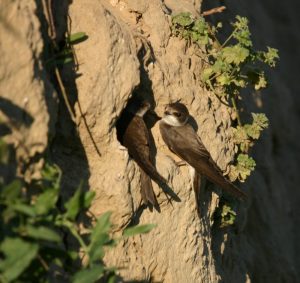
Annex I. Population size in the project area until 31.12.2011 – 0 – 300 pairs (significant annual variations). Nesting, migratory bird. Conservation status – threatened. Nesting of Sand Martin within the project area is restricted due to embanked of river and side arm banks as well as lowered flow dynamics – inside the river branch system no new steep banks are created anymore.
In the past there were huge nesting colonies of this species along the whole Danube and Morava section. Regular presence of Sand Martin and its nesting populations is nowadays significantly reduced. Majority of potential nesting sites (steep banks) was covered by large amount of stones and reduced water dynamics causes that new steep banks are created only exceptionally. Proposed project actions will help to improve nesting and feeding possibilities for this bird species.
European Bee-eater (Merops apiaster)
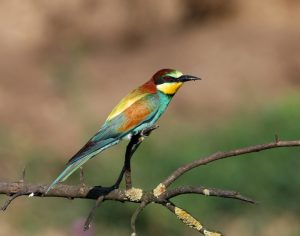
Birds Directive – Annex I. Population size in the project area – 100 pairs (in Slovakia nest according to latest estimation 700 to 1 300 pairs). Nesting, migratory bird. Conservation status – near threatened.Significant part of the population is concentrated in southern part of Slovakia, while its distribution is influenced by the offer of suitable nesting habitats. Bee-eaters need for nesting steep loess or clay-sandy walls. The major part of their diet consists of hymenopterous insects (wasps, bees), dragonflies, butterflies and various beetles. Bee-eater catches its prey during flight. It lives in colonies.
This bird is threatened mostly by degradation of steep nesting walls– their overgrowing by pioneer woody plants, establishment of landfills as well as reduction of food sources (large-scale use of insecticides causing significant loss of food). There are also known cases of direct persecution by plugging of nesting burrows and killing birds as a result of misunderstanding of its food behavior.

Project area consists of 5 Special Protection Areas (SPAs) belonging to the European system of protected areas Natura 2000:
There is lot of loess and sandy walls in this sub-site situated on natural terraces or in mining areas, which are surrounded by agricultural land and forest. SPA Dolné Pohronie consists of four independent parts located in eatern Podunajská nížina. All of the four parts are localized in the area of aeolian sediments – loess and sand with characteristic steep vertical walls. These steep walls are located either in parts where sand mining took place or on the edges of alluvial terraces. Dolné Pohronie is one of the three most important areas in terms of nesting of European Bee-eater in Slovakia, with estimated population size of 70 nesting pairs. Steep walls offer nesting conditions also for Sand Martin even though this species occur here very rarely.
Most fertile parts of the area have been converted to agricultural land, other to forests – usually by non-native species of trees, mostly locust tree. Less valuable areas were left without any management. For this reason, an abandoned area began to overgrow with vegetation, shrubs and trees in most cases by non-native or invasive species.
This area is located in Pannonian lowland along the bottom parts of rivers Váh, Vážsky Dunaj, Nitra and Žitava. Water regime of Váh continuing as Vážsky Dunaj, Nitra and Žitava is a determining factor affecting the habitats in the area. SPA works as a biocentre and also important migration route for different kinds of animals as it is situated near confluence of three rivers. It consists of different habitat types: water bodies, wet meadows, agricultural land, deciduous forests, non-forest areas and others. The aquatic habitats are represented by marshes, isolated oxbows, calcareous peatlands, wet meadows and habitats along rivers and their floodplains. River streams were highly regulated during 19th and 20th centuries. Water regime of the area is highly influenced by artificial system of channels (often copying the depresions of former stream beds). Ground water level increases during floods or long rainy season, which fills the natural depressions, low-lying riverbeds, oxbows, marshes.
Traditional grazing of meadows was abandoned and majority of this area was transferred into agricultural land or is managed by mowing. Majority of forest stands were changed into plantations of hybrid Poplars, only in some restricted small locations remained stands of native tree species left to natural succession process. Important landscape element in farmland is scattered wooden vegetation, dominantly represented by pollard willows and native species of Poplars.
The site refers to 172 km long section of the Danube river demarcated with the left-sided tributaries Morava and Ipeľ. The site includes a rich network of river branches and adjacent wetland complexes. Especially in the upper part of the area on the alluvial cone is the river branch system exceptionally rich developed and it constitutes the so called Danube inland delta (between villages Dobrohošť and Klížska Nemá). Massive river activity created a mosaic of different habitats which are shaped by the flood regime. Here we can find mixture of soft- and hardwood floodplain forests, fragments of Pannonian forest, dry forest steppes and lowland hay meadows. Aquatic habitats in the territory are represented by a wide range of its different types; The main factors that determine their ecological conditions are flow rate, size, age, water regime and the possible drying out period with insufficient rainfall. Terrestrial habitats are shaped by the regime of flooding, soil type, groundwater level and human management. In the past vast part of this area was grazed by herds of cows and horses. Nowadays most of the former pastures were transferred into arable land or are used for planting of hybrid poplars. This area represents very important migration corridor for many bird species.
This sub-site includes Slovak section of the Morava River between Skalica and its confluence with the Danube, as well as the most valuable part of the floodplain area near the Czech and Austrian borders with well preserved and developed complex of diverse habitats – streams, channels, river, oxbows, swamps, seasonal pools, wet grasslands, forests, meadows, etc. Záhorské Pomoravie has been identified as one of the key sites of the European Green Belt, following the border line protected by the “iron curtain” across the Europe. During socialism this area was strictly protected and thanks to absence of human activity natural processes could work and the original lowland character of landscape was preserved. Flora of this sub-site is represented approximately by 530 species of vascular plants, many of them endangered according to national Red List. According to its avifauna Záhorské Pomoravie represents one of the most valuable sites in Slovakia – it is important migratory corridor, feeding, nesting and wintering place of waterfowl.
Parížske močiare site is located in southern Slovakia near the village Gbelce in floodplain of regulated brook Paríž. This sub-site consists of three separate parts. It extends along about 5 km section, wetlands continue in a narrow strip further to the west to the Strekov village. There are extensive marshes and reed, sedge and bats vegetation with presence of sand terraces which used to provide suitable conditions for nesting of European Bee-eater in the past. Water regime is artificially regulated. It is important nesting and feeding area for waterfowl as well as important place for migration and wintering.
The project will carry out the activities briefly described below. Activities are defined and marked according to the requirements of the LIFE program, through which the project is funded. We will inform you about the results of ongoing activities at this project website.
A. Preparatory actions, elaboration of management plans and/or of action plans
A.1: Expert study on restoration of steep river banks and nesting walls
Basis for this study is mapping of the project area and selection of particular localities for restoration. In case of steep river banks (first part) the study will be elaborated on the basis of historical data about nesting of target species and current hydrological conditions. The second part of the expert study will be dedicated to the selection of the most suitable localities for the restoration of the nesting loess and clay-sandy walls outside the inundation zone.
A.2: Expert study on restoration of selected river branch systems
Expert study will specify the most perspective river branch systems and/ or river branches for restoration from the proposed preselected river branch systems. If needed hydrological and mathematical model of river branch systems will be elaborated. As the second step detailed technical documentation for specific actions including geodetic survey will be elaborated.
A.3: Expert study on restoration of riparian forest stands and vegetation
The study includes mapping of possible places for planting of native trees in the project site, especially near the river branch systems, as well as the presence of the old native tree species in the large plantations of hybrid poplars and other commercially planted species and forest stands near areas where Kingfisher occurs.
A.4: Expert study on restoration of feeding habitats of target bird species
Expert study on restoration of wetlands, small periodically flooded terrain depressions and grazed grassland habitats in the vicinity of nesting sites of target bird species will be a base for works aimed at restoration of currently missing feeding habitats.
B. Purchase and/or long-term lease of land
B.1: Purchase and/or long-term lease of land
Land will be purchased (65 ha) and leased (40 ha) especially in strategic locations important for target bird species – for their nesting, feeding, resting or as buffer zones for protection of their nesting localities; targeted land includes natural habitats or degraded land with high restoration potential.
C. Specific conservation actions
C.1: Restoration of steep river banks and nesting walls
During the 19th and 20th century, significant part of the river banks of Danube and Morava rivers in were insensitively embanked by heavy stones what caused a loss of natural nesting habitats for Sand Martin, Kingfisher (e.g. high steep exposed river banks) and on some sites also for European Bee-eater (e.g. loess and clay-sandy exposed terraces). Plenty of suitable habitats were degraded gradually according to intensified sedimentation of transported material which is a consequence of artificially changed water regime.
Our goal is to restore nesting places in steep banks by removal of embankment made of heavy stones on several sections where natural erosion will not negatively influence human activity and on the other hand can bring positive changes for original animal species. These actions include the main flow of the Danube as well as Morava. The second part of the activity is focused on restoration of loess and clay-sandy terraces or river banks which represent natural nesting habitat for European Bee-eater/Sand Martin.
C.2: Restoration of river branch systems for natural restoration and long-term maintenance of nesting habitats of steep river banks
Complete change of water regime river branch system of inland Danube delta due to their separation from the main stream (19th and 20th century) caused the loss of the natural dynamics and disappearance of some habitats of the Danube river ecosystems in Slovakia. At the same time this modification has caused gradual degradation leading to the complete disappearance of the target species nesting options due to increased sedimentation rate and subsequent overgrowing of natural vertical riverbanks by vegetation.
Based on the results of an expert study (A.2) and in collaboration with experts from different fields (State nature protection, water management, zoology, ecology and others) will be restored water regime of several originally flowing side river branches of Danube or whole river branch systems. Based on detailed technical documentation an isolated section of the shoulder systems shall be linked together, side arms will be connected to the main flow of the Danube, existing barriers in the flow will be removed or modified. These measures will help to restore the natural dynamics of the hydrological regime, leading in turn to natural regeneration and especially long-term maintenance of the target species breeding habitats with positive effects for many original animal and plant species of Danube. As the number of potential sites is beyond the scope of this project, recovery will be selected for those with the greatest potential.
C.3: Protection and restoration of riparian forest stands and vegetation in the nesting habitats of Kingfisher
Nature of much riparian vegetation has changed significantly as a result of radical changes in the hydrological regime. As a consequence of the loss of water dynamics its impact on bank growth and the natural bank erosion disappeared including the formation of nesting opportunities for Kingfisher. As a result of the shortage of exposed steep river banks Kingfisher was forced to find alternative ways of nesting in the root system of uprooted old trees. Suitable riparian vegetation can provide secondary options for nesting and gathering of food (perching on branches above the water). However intensive forest management significantly reduced the appearance of natural riparian vegetation and management methods in close proximity to river branch systems and wetlands negatively affect their character as well as an important biological function.
Within this activity the original old trees located directly or in close proximity to riparian vegetation will be sought and subsequently labelled. The uprooted trees will be labelled too, the maintenance of which will be communicated to owners /users of the mentioned vegetation cover/ land. The aim is to protect such trees from logging or removal especially in the areas where there may be no other possibilities to restore the natural habitat of this species. To improve the condition of the natural riparian vegetation the bush and invasive species will be removed, which by their dense overgrown prevent the target species from using the land. Afterwards, the appropriate mix of native tree species will be planted in the vicinity of river branches in the territory.
C.4: Restoration of feeding habitats of target bird species
Within this action is planned restoration of feeding habitats placed near the nesting habitats. The attention will be paid to small marshes, bogs, terrain depressions and grasslands (by supporting of grazing and restoring of lowland meadows).
Wetlands will be renewed in places of former marshy areas that have been dried by man or will be newly created close to the nesting sites. Wetlands will be restored by opening the original inlet areas that were covered, digging the new supply channels or else changing filling facilities if necessary. Technical objects (sluice-gates) will be used to retain water and to regulate water levels.
Besides these actions, in the framework of this activity will be assessed food preference of European Bee-eater as well as the possible impact of this species on the bees. Based on the results of this survey as well as the summary of known data from the literature will be defined recommendations for beekeepers.
C.5: Protection of nesting sites of target bird species
Protection measures include: fencing of nesting sites, closing of access roads, installation of caution and prohibition signs, camera security control and monitoring and seasonal sand and gravel extraction regulation. The aim of these actions is to reduce human activity in sites where these valuable species are nesting and so ensure their successful nesting.
D. Monitoring of the impact of the project actions
D.1: Monitoring of target species
1) detailed monitoring of populations of target species will be held within the project area prior to the implementation of restoration measures. The outputs of this monitoring will characterize the state of populations before the implementation of restoration measures. Following the beginning of the restoration measures annually mapping of populations of target species will be carried out including the monitoring of the state of suitable breeding habitats and counting breeding pairs. The results of this monitoring will be linked to the locations at which will be implemented various measures and will serve to evaluate the benefits of implemented activities.
2) the research of feeding behaviour and food composition of European Bee-eater by using appropriate non-invasive techniques
3) on the places where water and wetland habitats will be restored within concrete conservation measure we will continuously monitor fish species composition as indicators of ecological state of the localities
D.2: Monitoring of the socio-economic impact of the project actions
Project activities will be implemented in five areas (SPAs). Their nature will affect the range of socio-economic indicators. Monitoring of the socio-economic impact of the project activities will be prepared by specialists using standard methods and will be evaluated using adequate statistical methods. After the project end it will be possible to detect changes of the attractiveness of the area not only for tourists but also locals. The result of this activity will be monitoring report mapping the socio-economic impact of project activities on the local economy and population.
E. Public awareness and dissemination of results
E.1: Project website
Via the web site in three languages (Slovak, English and Hungarian) will be possible for the general public, professionals, students as well as representatives of interested groups of citizens (stakeholders) be acquainted with information about the project activities and results as well as the target species and the project area.
E.2: Communication and meetings with key stakeholders
As part of activities there will be organized meetings with all relevant groups of interested citizens (stakeholders) as representatives of municipalities, owners and land users and public authorities (regional and district environmental offices, regional and district forest offices, state and municipal police, Slovak Environmental Inspection etc.). At these meetings current project area conservation problems will be discussed with involved organizations. This activity will be carried out regularly throughout the project period.
E.3: Installation of information panels
A total of 10 information panels will be placed at strategic locations of the project area. Panels will provide comprehensive information on project activities, floodplain ecosystems and their bird populations. There will also be information about the local nature conservation, particularly in the context of the implementation of the Birds and Habitats Directives. Information will be preferably in the Slovak language, but also in Hungarian, German and English, and most particularly in cases/areas where it will be suitable. This activity will be implemented gradually throughout the project. The panels will also include information on the Natura 2000 network, including logos Natura 2000 and the LIFE + program and information on its importance and role in the protection of European landscapes and natural heritage.
E.4: Publishing of information, educational and promotional materials
To increase awareness of different target groups will be prepared leaflets, brochures, stickers, calendars, memory game and many other materials. Brochures and leaflets will be published in Slovak, English and Hungarian.
Information materials will be drawn focusing mainly on the professional public and experts in the field, members of the institutions concerned (staff offices, State nature protection, members of other non-governmental organizations) who can benefit from the experience and results obtained within the project. Information materials will be designed so that they will be a benefit also for stakeholders such as foresters, farmers, beekeepers, owners and land users, local residents, hunters, etc.).
Educational and promotional materials will be distributed also to the wider public (including children and students), focusing mainly on visitors in the NATURA 2000 sites with an effort to explain the impact of their behaviour on the valuable habitats and species of the protected areas.
E.5: Documentary film
The film will be made about the target species and the relationship to their habitats and threats which are threatening their population. In the film we would like to bring closer the basic biology of species including their ecological strategies and natural habitat requirements. Part of the film will stress the examples of optimal nesting habitats and negative factors and actions causing their endangerment and decrease in population number. The individual situation before restoration of habitats, examples of restoration works and of habitats after their recovery for comparison will also be shown. Via the document we present the current situation of these species and their habitats (nesting and feeding) in the Danube-Moravian region and emphasize the need for their protection. Part of the film will be devoted to LIFE + project, its purpose, its achievements, restoration measures, monitoring of the objectives and the overall concept of Natura 2000. The film will be presented in the media, on the website, distributed on DVD to the public and stakeholders. It will be produced in three languages version (Slovak, English and Hungarian).
E.6: Exhibition
The exhibition will show to public in a very effective way the importance of the protection of the targeted species and habitats. It will be focused on the ecology of Kingfisher, Sand Martin and European Bee-eater. It will explain interesting facts of their lives in attractive way – nesting, migration, looking for food and at the same time will explain specific nesting and feeding habitat requirements of particular species. Within the exhibition, basic factors threatening the life of these birds will be presented. The exhibition will contain diverse interactive components designated for diverse age categories. Part of the exhibition will also be an interactive game through which participants can try to be in the shoes of Kingfisher, European Bee-eater or Sand Martin.
The exhibition will have a traveling character – during the project it will be installed at several locations within Slovakia, Hungary eventually Czech Republic or Austria in the first phase, especially in places that are somehow related to the project area. Gradually, the exhibition will tour all significant centres that have similar activities in its program and at the same time focus on environmental education and popularisation of nature protection including cross-border region.
E.7: Presentations and field excursions for schools and public
Within this activity numerous presentations and field excursions for schools and public will be organized. The professional guides will guarantee an excellent level of excursions, of information about the project, project area, target species and the system of protected areas Natura 2000 as well as the objectives and the opportunities provided by the European Commission under the LIFE. The quality and experience of lecturers and guides will ensure the participants will get first-rate information and pleasant experience (professional presentation, answering questions, guidance at the most attractive natural sites within the project area, wildlife observation, etc.). Guides will also supervise a compliance with the rules of behaviour in nature during excursions. For each group of participants will be selected different intensity and duration of lectures and in case of excursions will be selected routes with varying degrees of difficulty. There will also be an offer of attractive excursions by boat or bicycle together with bird watching.
During presentations for students and the public will be used modern audio-visual equipment (slide show, sounds and video records). Lectures for students will contain except the information about the project and Natura 2000 also contain information on target species and their biology and will be presented in attractive way – including illustration of basic research, the identification of the species, of the bird parasites, etc.
This activity will be implemented throughout the entire duration of the project.
E.8: Promotion of project on conferences and in media
This activity includes two main parts: (1) propagation of the project on conferences and (2) in media. The project will be presented to expert audience during conferences and expert meetings and also to wide public via media. Promotion of the project, its objectives, methods and conservation achievements are useful for obtaining higher support for the implementation of the project within the local population and the overall increase of public awareness. Conferences will be held in the project countries and elsewhere abroad. Regular contact with the media – newspapers, magazines, radio, television at local, regional and national levels will be introduced. Information for the press will be published regularly through press releases, media briefings, interviews, news reports from the field, etc. Media outputs will promote the project and its objectives. This activity will be carried out throughout the entire duration of the project. Media outputs will also be updated on the website of the project.
F. Overall project operation and monitoring of the project progress
F.1: Project management
This activity will be provided for overall management of the project by the project manager, assistant and other positions in the project. Project staff will be employed throughout the entire duration of the project. External subcontractors, suppliers of goods and services will be selected by public tender following the timetable of implementation of the project. Project Office is based in Bratislava. At the beginning of the project the Project Steering Committee will be appointed from representatives of the project partners and representatives of the State Nature Conservancy of the Slovak Republic, an independent scientific authority, the Ministry of Environment and key stakeholders (e.g. SVP) who will oversee the entire course of the project .
F.2: Project bookkeeping and financial management
This activity is necessary to ensure overall project bookkeeping and preparing accounting documents for monitoring reports and project reports as well as documents for audit.
F.3: Networking with other projects and institutions
This activity is focused on networking of the project staff with staff of similar ongoing and completed projects. As part of the mutual visits will project staff exchange experience in implementing of different approaches to tackle similar conservation issues and consider options, pros and cons of the proposed project activities. There will be an opportunity to discuss different approaches with more experienced and less experienced partners and thus avoid failure of the proposed activities under the project or help the partners to prevent their failures and errors. The cooperation will be established with similar projects focusing on endangered bird species, rivers, wetlands and floodplain forests and project visits will be carried out. Protected areas with similar problems, natural conditions and socio-economic background will be selected for networking. Therefore, projects along the Danube and Morava will be preferred. The proposed project solutions will be discussed with experts from other project areas. Many experiences will be presented to key stakeholders and authorities. This activity will be carried out throughout the entire duration of the project.
F.4: Project auditing
All financial statements for the European Commission will be verified by an independent auditor. This activity will be carried out throughout the entire duration of the project since the nomination of an independent auditor.
F.5: After-LIFE conservation plan
At the end of the project will be prepared document – “Protection plan after the project end” which will describe the continuation of project activities after they are finalized to ensure long-term protection of undertaken measures, target species and their habitats in the project area.
A. Preparatory actions, elaboration of management plans and/or of action plans
Before the implementation of specific restoration measures within the project, it is necessary to have sufficient technical documents on the basis of which the actual restoration measures can be designed/planned or, at the last stage, implemented. This concerns the restoration of steep river banks, the reconnection and restoration of river arms or river branch systems, but also the restoration of floodplain forests or feeding habitats in the form of extensive pastures, mown meadows in floodplain forests or wetlands.
This important preparatory phase involves experts from various fields of technical and natural sciences, such as water experts, zoologists, ecologists, environmentalists and, where appropriate, specialists in the specific areas affected by the restoration measures.
A.1: Expert study on restoration of steep river banks and nesting walls
Populations of Sand martins, Kingfishers and European bee-eaters in the Danube and Morava regions are limited by suitable nesting opportunities. All three species are characterized by nesting in vertical walls in which they create nest burrows. The aim of the activity was to prepare an expert study focusing on steep river banks and nesting walls outside the floodplain. The study was elaborated from a hydraulic and hydrological point of view (VÚVH), as well as from a biological and ecological point of view (PriF UK). The study included the specification of bank sections in the Slovak part of the Danube and Morava rivers suitable for restoration. All available hydrological, topographical and technical data were collected for both rivers where steep bank restoration was considered. Analyses of flow velocity, flow direction, water level, shear stress and channel material were realized on all selected sections.
During the preparation of the biological and ecological part of the expert study, experts from the Faculty of Natural Sciences, Comenius University Bratislava, summarized historical and biological data on the target species and their breeding sites within the project areas. Together with an assessment of the current environmental and nesting conditions of each site, they prepared a second part of the expert study focusing on the ecological parameters of the selected river bank sections. At each site, selected ecological characteristics (e.g. availability of feeding habitats, suitable river bank height for nesting) were defined and compared with available historical data on nesting of target species along the Danube/Morava rivers.
This study also describes the current conservation status of the habitats, their main threats and proposes the most appropriate ways of restoration management in the target SPAs.
Activity A.1 also included the development of technical documentation for selected river bank sections, which were subsequently restored as part of Activity C.1. An important part of Activity A.1 is the time-consuming permitting processes. In addition to the consent of the district authorities – the Environment Department, in the case of the Danube and the Morava, the Commission for Boundary Waters had to be asked for agreement for the implementation of the measures, as in both cases these are our boundary rivers. An important step in all permitting processes was also the consent of the SVP, or some private owners of the land on which the restoration measures were implemented.

A.2: Expert study on restoration of selected river branch systems
Alluvial areas depend on dynamics. This means that the flow of the river should lead to both erosion and sedimentation and that water levels naturally fluctuate. Many endangered plant and animal species depend on these changing conditions. Connecting the side arms to the main flow of the Danube will restore at least part of the Danube delta to its original function as an artery in the floodplain forest.
The activity was divided into several phases. The first step was the elaboration of an expert study that defined potential sites for the restoration of the arms, together with technical, hydrological and hydromorphological parameters. It then went on to develop the technical documentation for three specific river side arms, negotiating and obtaining the necessary representations and construction permits. As part of the negotiations, representatives of the SVP – as the river manager – gave their opinion on the water level at which the arms can be opened and as the landowner gave their approval for the implementation of the restoration of the specific arms. The negotiations with the SR Forests were also a challenging part of the search for an agreement on which sites the restoration measures would be implemented. The Slovak Fishermen’s Association also participated and commented on the negotiations. Once a consensus was found, we were able to proceed to the last phase of restoration, namely the public procurement of each sub-measure.
The main objective of the expert study developed by the VUVH was to propose and assess restoration measures that could improve the lateral hydrological connectivity between the main Danube river water course and its branch systems in selected locations.
The design of the measures has been developed with regard to the Water Framework Directive 2000/60/EC. An analysis of the historical and morphological development of the Danube River and its inflow system was prepared in order to propose appropriate measures. The hydrological and hydraulic data were collected and analyzed and the hydrological regime at selected sites was subsequently determined.
In the framework of Activity A.2, technical documentation for the restoration of the Kľúčovské, Šulianske and Veľkolélske river side arms was prepared.

A.3: Expert study on restoration of riparian forest stands and vegetation
The objective of the study was to map potentially suitable sites for restoration of floodplain forest near the river arms and to identify old trees in areas of Kingfishers occurrence that should be marked and protected from felling as possible replacement nesting sites for Kingfishers.
The expert study for the restoration of riparian vegetation included two main parts:
The first part focused on sites with riparian stands adversely affected by intensive forest management and the second on sites where forest management plans to cut down stands according to the current forest management plan in force for the period.
Attention was focused on obtaining and processing information on planned forestry measures within the project site, especially in the SPA Dunajské luhy and Záhorské Pomoravie. A number of meetings were also held with experts from the SNC SR (State Nature Conservancy of Slovak Republic) and SR Forests with highly positive results for the expert study and for the subsequent implementation of activity C.3. Based on the information and negotiations, BROZ implemented several changes in the forest management plans for the next decade. The categorization of several forest stands was changed from management to special purpose forests, including several riparian stands in the Danube Floodplains Special Protection Area. As a result, these stands were not designated for commercial use and the old trees were preserved.
The second part of the A.3 activity was mapping of riparian vegetation focused on searching for old trees and native tree species among hybrid poplar monocultures. Old growth and native tree species mapped within these monocultures for harvesting were identified and preserved even in forest stands that are heavily commercialized.
The old stands and native tree species mapped within these monocultures slated for harvesting were also identified and preserved in forest stands that are heavily commercialized. Approximately 200 of the mapped and identified trees are of exceptional quality, represent typical examples of specific native tree species and meet the parameters for potential designation as protected trees. For these trees, basic data such as species, trunk circumference at breast height and GPS coordinates were recorded.
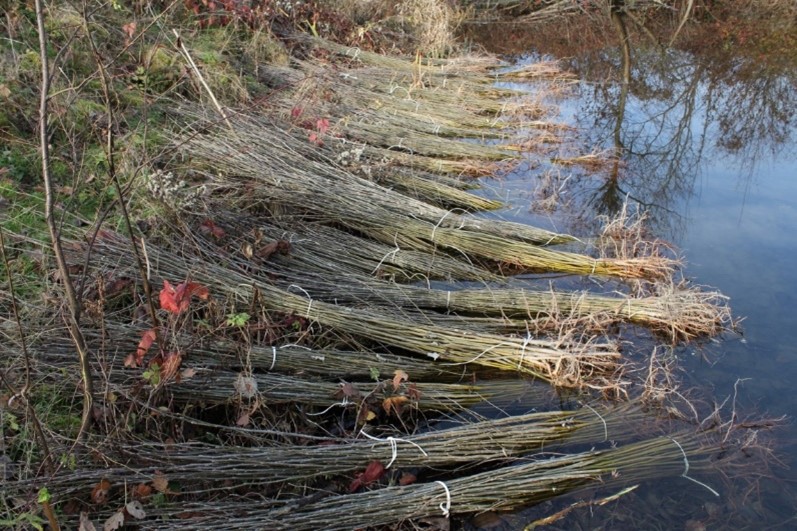
A.4: Expert study on restoration of feeding habitats of target bird species
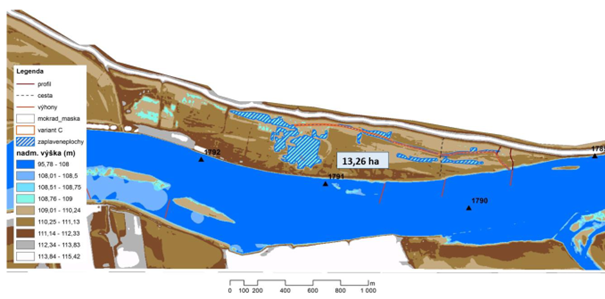
C. Conservation activities
C.1: Restoration of steep river banks and nesting walls
In the 19th and 20th century much of the banks of the Danube and Morava rivers in Slovakia were fortified with rubble or stone paving, which caused the loss of natural nesting habitats for Sand martins, Kingfishers and in some places also for European bee-eaters, which used the high, exposed, steep river banks, similarly to the loess and sand exposed terraces. Many suitable sites have been destroyed by over sedimentation as a result of unsustainable changes to the water regime.
Within activity C.1, steep river banks and nesting walls were restored for 2 236 m (compared to 1 750 planned meters) at 13 sites within three SPAs – Danube Floodplains, Záhorské Pomoravie and Dolné Pohronie. The total length of restored banks and walls was almost 28% longer than originally planned in the project. The field work started in 2017 and continued until 2022.
As the very first wall, the steep bank was restored in 2017 in the Veľkolélske river side arm in the area of Zlatná na Ostrove in a total length of 35 m
In 2017, we also restored nesting walls at 3 sites in Bátorove Kosihy with a total length of 608 m (2017).
The last restored site in 2017 was the steep river bank on the Danube river arm in Dobrohošť, 40 m long.

In 2019, we restored a steep river bank in Bratislava Ružinov with a total length of 281 m.
In 2020, the nesting walls in the Záhorské Pomoravie SPA were restored. It was possible to prepare 115 m in Gajary and 20 m in Plavecký Štvrtok for the project species. During the nesting season, a large colony of European bee-eaters was recorded at the site. The restoration works were implemented in cooperation with the representatives of the Záhorie Protected Landscape Area (SNC SR).
In October 2020, the construction site on the Petržalka bank of the Danube river was handed over. At the beginning of 2021, the restoration of approx. 420 m of the steep bank at the place known for the nesting of the Sand martins in the recent past. Approximately 500 pairs of Sand martins nested at the site in the 2021 breeding season.
In 2022, after previous negotiations with the SVP Malacky and in cooperation with the Administration of the Záhorie Protected Landscape Area, we managed to restore two sections of the banks of the Morava River, 150 m in the cadastral area of the village of Gajary and 115 m in the cadastral area of the village of Malé Leváre.
In 2022, we also restored two short sections of the banks in the Danube Floodplains, namely in Veľký Lél 50 m and in Iža 15 m.
After obtaining consent from the landowner in the area of the planned bank modification in the cadastral area of the village of Chľaba, the VVB representatives initiated the acquisition of all other necessary agreements so that the works could be implemented also in this locality. In 2022, 235 m of steep river bank was restored here.

The last section to be restored was a 150 m section of the bank of the Istragov river arm.
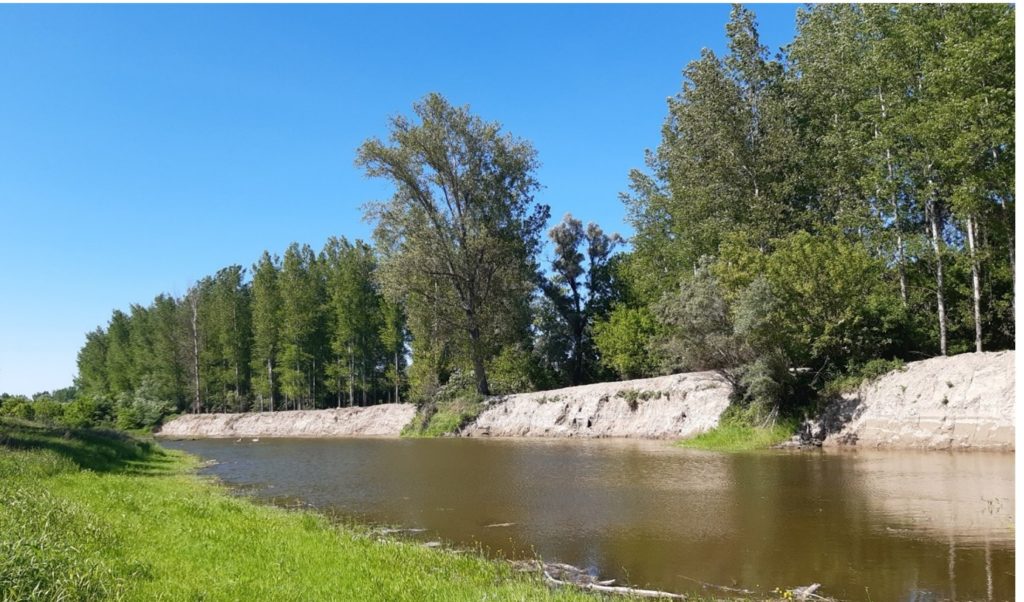
Overall, it was restored:
- 265 m on the main water body of the Morava River,
- 1 003 m on the main water body of the Danube
- 225 m have been restored within the Danube branch systems
- Nesting walls have been restored for a total length of 743 m
- in the Záhorské Pomoravie SPA, banks and walls were restored for a total length of 400 m
- in the Danube Floodplains SPA, steep river banks were restored for a length of 1228 m
- 608 m of nesting walls were restored in the Dolné Pohronie SPA
Nesting of target species was recorded at 6 sites directly after bank/nesting wall restoration. At the other sites that were restored during 2022, there is a high probability of nesting opportunities being used during the following breeding season. All sites will be monitored for this purpose during the next nesting season.
C.2: Restoration of river branch systems for long-term maintenance of nesting habitats of steep river banks
The aim of activity C.2 was to restore 3 main river arms with a total length of 3 600 m, which included the restoration of their water regime and river dynamics. The restoration of the river branch systems is a key activity of the project and the restoration of natural processes leading to the creation of nesting opportunities and a varied food offer for the target bird species.
Within the project, we have managed to restore three river side arms with a total length of 4878 m. All restored river side arms are located in the Danube Floodplains SPA and include:
1. Kľúčovské river side arm restored in 2019
In November 2019, after several decades and several years of effort, the connection of the lower part of the Klučovské river side arm to the Danube was restored. A side overflow was built at the location of one of the original inlets into the arms at river kilometer 1802.5, allowing Danube water to flow into the branch system. A kilometer-long stretch of the channel was also cleaned, which will contribute to restoring the dynamics in the arms and will also significantly improve the capacity of the system during flood flows.
By 2020, the renewed dynamics of this part of the river branch system was already evident in the whole restored section of the Kľúčovské river side arm up to the outflow into the Danube. Thanks to the abundant flows in the Danube and now also in the Kľúčovské river side arm in the second half of 2020, the Danube itself has already shaped the restored channel and fish have entered the arm almost continuously.
Thanks to the restoration, new feeding and nesting habitats have been created for the target species of the project, as well as many other species of animals and plants.
2. Šulianske river branch system restored in 2021 and 2022
The restoration of the Šulianske river branch system was realized in two phases in the years 2021 and 2022. The main measure in the first phase was the replacement of the pipe culverts with prefabricated frame culverts with suitable parameters to allow the passage of a sufficient amount of water and at the same time to allow the migration of aquatic animals. A fish pass of approximately 125 m was constructed to allow fish migration between the different parts of the arm during periods of low and high flows occurring during simulated floods. Works started in March 2021 and finished in October 2021.
The second phase of work focused on the restoration of the inflow area and several sections of the arm. BROZ was responsible for this phase. The inflow area was widened to its original width with a small central island, which increased the amount of water flowing into this part of the arm. The cleaning of several sections of the arm and the restoration of the steep banks as part of the dredging also contributed to the improvement of the water dynamics in the arm.
3. Veľkolélske side arm system restored in 2021/2022
The work on the restoration of the water regime in the upper part of the Veľkolélske side arm system included:
- connecting the side arm to the main flow in the upper part by constructing a new inflow structure
- restoration and deepening of the upper part of the arm system for a length of 480 m
- dredging of selected sections of the side arms where flow obstructions were identified that would negatively affect the flow of water in the Veľkolélske side arm
The Veľkolélske side arm is one of the widest side arms of the Danube in the Slovak section of the river. Originally, this arm was up to 200 m wide in places and was supplied with water from 5 wide inflow areas. The measures taken have contributed significantly to improving the conditions and water flow in the extensive upper area of the inflow arm system and have made it possible to more than double the amount of water flowing from the main river bed of the Danube. All hydrological and hydromorphological parameters of the arm have been significantly improved thanks to the implemented measures, to which all components of the biota formerly related to the dynamic flowing side-arm systems of the Danube, including target bird species, will gradually respond. The results of this activity have a long-term effect and, in river sections without artificial regulation, are the most important for achieving good breeding conditions and a significant improvement in habitat quality.
C.3: Protection and restoration of riparian forest stands and vegetation
The aim of activity C.3 was to provide marking and protection of at least 1 500 old trees of native species at sites with planned logging throughout the forest area of the target SPAs. On the basis of the data and recommendations from the study developed in the framework of the preparatory action A.3, the planting of riparian vegetation was implemented only in the Danube Floodplains SPA.
Within the framework of Activity C.3, a total of 20 475 deciduous tree seedlings were planted during the project duration in 19 sites covering an area of 16.24 ha with a predominance of soft riparian forest species occurring in areas that are more frequently or long-term flooded.
We used seedlings grown from genetic material coming directly from the Danube Floodplains protected area, there were 6 species of trees: Salix alba, Populus alba, Populus nigra, Alnus glutinosa, Quercus robur, Fraxinus angustifolia.
In 2016, 7 600 seedlings of native tree species typical of the floodplain landscape were planted within the project. In 2017, 11 400 seedlings of native tree species were planted. In 2017-2019, after-planting care was provided on a regular basis, which increased the chances of successful survival of the young trees.
Young trees located in areas with a high number of wild animals (especially deer) were secured with fencing to prevent the destruction of trees by biting. After-planting care included the control and repair of fencing where it had been damaged.
As part of the activity to protect old trees of native species, old stands and native tree species in monocultures of hybrid poplars or other forest stands to be felled were mapped. They were also identified and preserved in forest stands that are intensively exploited commercially.
All the planned 1500 old valuable trees have been marked in the SPA Danube Floodplains and SPA Záhorské Pomoravie.

C.4: Restoration of feeding habitats of target bird species
Within this activity, the restoration of feeding habitats located in the vicinity of the nesting sites of the target species was planned. Attention was focused on the restoration of small wetlands, marshes, terrain depressions and grasslands, both mown and grazed (by promoting grazing and restoration of lowland meadows).
As part of this activity, we monitored the food preference of the european Bee-eater as well as the potential impact of colonies of this species on honey bee colonies. Based on the results of this research as well as by summarizing known data from the literature, recommendations for bee keepers were defined.
Wetlands
Wetlands are a feeding habitat for all target bird species. Their restoration has brought higher species diversity to the area, but also a greater amount of food. In the first phase, small-scale measures were implemented to restore wetlands in the SPA Dunajské luhy and SPA Dolné Pohronie, and in the second phase, larger-scale measures were implemented in the cadastral area of the village of Klížska Nemá.
During the spring of 2017, four wetlands were restored by the BROZ with a total area of approximately 1.77 ha. Three of them were restored in the Danube Floodplains SPA in the cadastral area of Dobrohošt’ (0.84 ha + 0.5 ha + 0.35 ha)
One of the small-scale restored wetlands is located in the Dolné Pohronie SPA in the cadastral area of Bátorove Kosihy (0.08 ha).
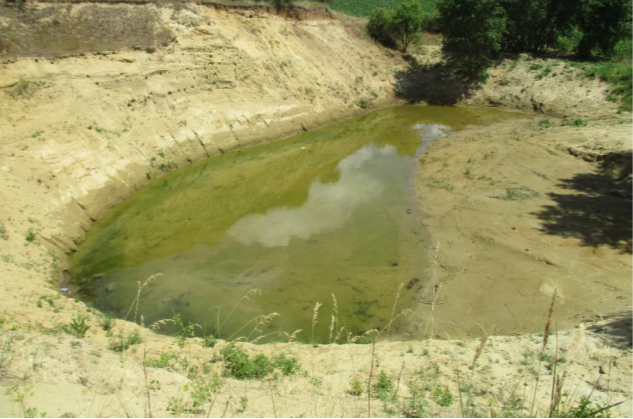
According to the expert study (A.4) in October 2020, the implementation of the action continued with the restoration of the large wetlands near the village of Klížská Nemá until March 2021.
The main measures implemented were: the construction of a new connecting arm with a length of approx. 150 m, which brings Danube water to the old arm and the surrounding wetlands, the construction of a connection to the nearby wetlands (length of the connection approx. 45 m) and the construction of a prefabricated frame culvert at the junction of the old arm with the forest road.
In addition, we also have created a series of permanent wetlands in the Klížská Nemá cadaster by dredging deeper areas that are connected to the groundwater and are not so dependent on the water level in the Danube.

Meadows restored by weeding and mowing
1. Gabčíkovo: The first site with restored meadows was near Gabčíkovo. On arable land, three separate but contiguous parts were restored, totaling 10 hectares. The area was previously used as agricultural arable land. For the restoration, a natural mixture of native grass and herbs was selected and sown during April 2014. The area of restored grassland on the site was increased by a further 4.3 ha in spring 2017 and a further 3.5 ha in August 2017 through targeted land leasing. In total, 18.7 ha of grassland has been restored on this site. All of the restored sites are very well located in relation to nesting sites of the target species – in particular the European bee-eater.

2. Bratislava – Petržalka and Bratislava – Ružinov: On both sides of the Danube directly in the capital, extensive meadows with a total area of 52.8 ha were restored. The meadows, which had been abandoned for several years, were completely overgrown with goldenrod (Solidago gigantea, S. canadensis) and other invasive plants, shrubs (Swida sanguinea, Rubus agg.) and trees (Negundo aceroides, Fraxinus pensylvanica). Both sites are located behind a long stretch of the Danube banks and are included in an expert study of potential sites suitable for restoration as feeding habitats for the target species. Until 2012, the Sand martin regularly nested on both banks. Grassland restoration in the study area started with milling of shrubs and young trees and multiple mulching (April-September). The process was repeated several times. During the duration of the project, 34.66 ha of grasslands maintained as meadows were restored by mowing in Petržalka and 18.15 ha in Ružinov.
3. Čičov: In this area, 5 parts of meadows were restored. The arable land was sown with natural seed mixtures in spring 2017 on two sites with a total area of 5.5 ha and another 3 sites with an area of 13 ha were restored in the same way in 2022. The conversion of arable land to grassland was made possible by the purchase of arable land from a number of private owners, including the local agricultural company AC Sokolce.

4. Kľúčovec: Restoration of the feeding habitats at this site was implemented in 2022, when dispersed arable land of 1.12 ha was bought and handed over to the BROZ for use. The type of restoration was similar – conversion of arable land to grassland by sowing a natural seed mix

Grassland – pastures
Living mowers naturally preserve and significantly improve the meadows in the municipality Radvaň nad Dunajom (SPA Dolné Pohronie), Veľké Kosihy and directly on the territory of Bratislava in the municipality of Ružinov (SPA Dunajské luhy). Thanks to grazing, the expansion of invasive plants in unmanaged areas has been reduced, the biodiversity of plants and animals has increased significantly and, as a result, the food supply and its diversity for insectivorous Sand martins and European bee-eaters has also increased.
Restoration of feeding habitats by grazing and establishing pastures has been more difficult than expected. During the duration of the project, a number of meetings and negotiations with local farmers within the Danube Meadows SPA, Záhorské Pomoravie SPA, Dolné Pohronie SPA and Dolné Považie SPA took place. Within the Danube Floodplains SPA and the Dolné Pohronie SPA alone, pastures have been established on 3 sites with a total area of 35.9 ha.
1. Pasture in cadastral area Radvaň nad Dunajom is located on a sand dune near the nesting wall, which is used for nesting by European bee-eaters and Sand martins. In addition, the relatively rare nesting of European bee-eaters directly in the ground is also known from this site. During the first phase of restoration (2017), the 12 ha site was fenced with a new electric fence with a total length of 2,000 m. The area was grazed by the animals of a local farmer (horses, sheep, cows). In 2019, thanks to negotiations with landowners and a local farmer, we managed to increase the area of grazing land. In March 2019, a special mixture (90% grass, 7.3% herbs, 2.7% clover) was used for sowing. In 2020, it was possible to extend the permanent fencing for grazing horses and cattle in the Dolné Pohronie SPA. The meadow, which was restored in 2019 on the ploughed parts of the SPA and it is regularly maintained by using of living mowers. Thanks to this management, the beautiful extensive pastures located in the cadastral territory of Radvaň nad Dunajom have been restored and expanded by 2.4 ha. European bee-eaters and Sand martins nesting in this area have more extensive hunting grounds with a varied food supply.
2. In May 2016, the Dunajské luhy SPA near Komárno, in cadastral area of Veľké Kosihy, a small overgrown meadow with an area of 1.5 ha was restored by milling trees and mulching. The site has been grazed by sheep of a local farmer since 2017.

3. Bratislava – Ružinov: Since 2016, the restored area in Bratislava – Ružinov has expanded by another 20 ha by grazing sheep in the upper part of the overgrown alluvial meadows. The rugged terrain makes machine mulching and mowing difficult, so grazing is the optimal way to restore and manage this area. Grazing in this large site increases biodiversity and insect density and is also a good combination with the managed meadows, which serve as feeding habitats for Sand martins from the breeding colony on the opposite bank of the Danube.

Beehives
In 2016, 25 beehives with bee families and necessary equipment were purchased and placed in the Danube Floodplains protected area. A cooperation agreement was signed with a local beekeeper. During the breeding period, the foraging behavior of the bee families and the composition of their food were monitored.
Another 25 beehives with bee families were purchased in spring 2018 and placed in the Dolné Pohronie protected area. A cooperation agreement was also signed with a local beekeeper from Marcelová. The beehives were located close to a nesting colony of European bee-eaters, directly on the site where the restoration of the pasture as a feeding habitat was implemented.
Thanks to the location of the beehives in two sites with different management (pasture vs. no grazing), it was possible to compare the foraging behavior of European bee-eaters in the two habitat types. This comparison provided very useful and interesting results, which were also intensively communicated in the beekeeping community.

- during the implementation of activity C.4, grassland was restored on 8 sites, 3 pastures with a total area of 35.9 ha and 5 mowing meadows with a total area of 90.1 ha
- wetlands have been restored on at least 15 ha within 3 sites, which may increase up to 29 ha depending on the water level of the Danube.
- two separate mobile beehive units have also been installed in the vicinity of the European bee-eaters nesting colonies to monitor the foraging behavior and food composition of the European bee-eaters.
C.5: Protection of nesting sites of target bird species
Activity C.5 was implemented during the whole duration of the project. Monitoring was focused on the Dolné Pohronie SPA and the Danube Floodplains SPA and in a later phase also on the Záhorské Pomoravie SPA.
The camera system was installed and used at active breeding sites during the breeding seasons. The system will also be used for other breeding seasons and other sites after the end of the project, if necessary. A total of 10 ramps and 30 signs were installed during the duration of the project, including 9 traffic signs and 21 information signs at 12 locations in the Danube Floodplains SPA, Dolné Pohronie SPA and Záhorské Pomoravie SPA.
In 2017, mobile fencing was installed at the Bátorove Kosihy site to protect the restored nesting walls in this location. At the same time, a camera system was installed there to record any unwanted intervention in the nests of the project species. In 2018, ramps were installed to prevent motor vehicles from entering and disturbing the nesting sites of the project species.
In 2019 and 2020, prohibition and information signs were installed near known breeding sites and important feeding habitats of target bird species. They were also installed on access roads leading to breeding areas.
D. Monitoring the impact of project activities
D.1: Monitoring of project species and impact of project activities
Every year, colleagues from the Faculty of Science of Comenius University prepared a monitoring report, which is the result of their observations of the project species at the nesting sites in the project area. Particular attention is paid to the study of the diet composition of the European bee-eater.
Within the monitoring of the target species, 3 types of monitoring were carried out:
- monitoring of population characteristics of target bird species
- monitoring of foraging behavior and diet composition of the European bee-eater
- monitoring focused on particular fish species as indicators of the status of restored aquatic and wetland habitats.
Data on the numbers of breeding pairs of all three target bird species were obtained from the entire project period from 2014 to 2022. Populations of target species were most significantly affected by the restoration of steep banks and nesting walls (C.1) and the restoration of side arms (C.2), which directly impact nesting opportunities. The impact of activities C.3 and C.4 can only be assessed in the long term.
Examples of new nests created thanks to the project activities:
7-8 pairs of bee-eaters were recorded at sites in SPA Danube Meadows where we implemented restoration measures. For example, the banks of the Šulianske river branch:
After the implementation of the measures, the European bee-eater at the site in Bátorove Kosihy shows an increase in population within a few years:
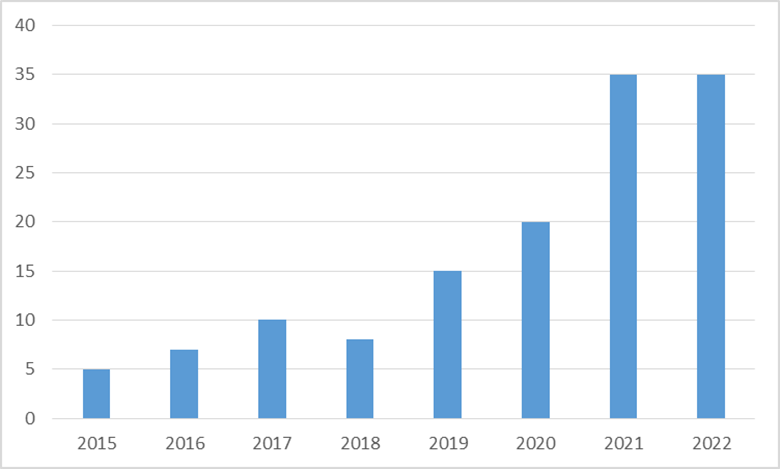

At the Radvaň nad Dunajom site (SPA Dolné Pohronie), the population of European bee-eaters has stabilized at a high number of 34-37 breeding pairs. The population is fully dependent on grazing, as individuals nest directly in the ground in the pasture and need low vegetation. Restoration and promotion of grazing at this location is essential to the long-term maintenance of the European bee-eater population.

Sand martins have colonized newly created banks in Bratislava Petržalka, where we found at least 300 nesting pairs.

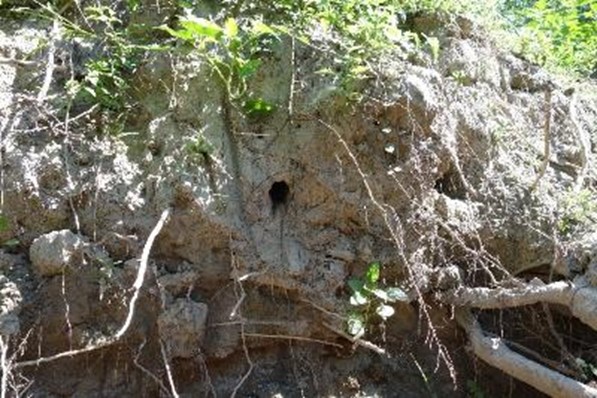
Extensive monitoring of the diet composition of the European bee-eaters has been carried out and some interesting facts have been found or confirmed:
– Honey bees are an important part of the prey of the European bee-eater.
– Due to the number of bees captured, as well as their age and health, there is no significant impact on the colony.
– The presence of European bee-eater colonies does not affect the amount of honey produced by colonies in the vicinity of these colonies.
– Biodiversity conservation measures (e.g. extensive grazing) can boost the abundance of both bee-eaters and honey bee populations at the same time.

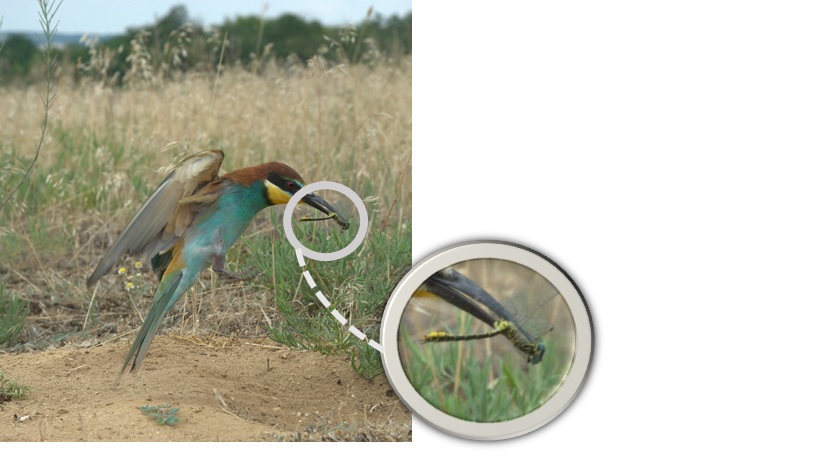
Ichthyological monitoring has been carried out at the sites of the two main restoration actions and the changes in fish species composition and abundance that have been initiated there have been documented.
Within the monitoring of the restored Kľučovské river branch, it was found that species of European importance and species included in the red list of crustacean and fish species of Slovakia deserve attention from the point of view of their conservation status. Of the species of European importance, we recorded Leuciscus aspius, Gymnocephalus schraetser, Rhodeus amarus, Romanogobio albipinnatus and Rutilus pigus. According to the annotated Red List of lampreys and fishes of Slovakia, 3 species belonged to the vulnerable category (Gymnocephalus schraetser, Rutilus pigus and Sander volgensis), 3 species to the near threatened category (Chondrostoma nasus, Leuciscus idus and Romanogobio albipinnatus) and 11 species to the less endangered category (Alburnus alburnus, Leuciscus aspius, Blicca bjoerkna, Cyprinus carpio (pond form), Rhodeus amarus, Rutilus rutilus, Scardinius erythrophthalmus, Squalius cephalus, Perca fluviatilis, Sander lucioperca, Proterorhinus semilunaris). Annex III “Protected Species” of the Convention on the Conservation of European Wildlife and Natural Habitats (Bern Convention) lists seven of the identified species, namely: Chondrostoma nasus, Gymnocephalus schraetser, Leuciscus aspius, Rhodeus amarus, Rutilus pigus, Proterorhinus semilunaris and Sander volgensis.
Within the monitoring of the Šulianske river branch, the occurrence of some endangered fish species was confirmed. In terms of conservation status, species of European importance and species included in the Red List of Crustaceans and Fishes of Slovakia deserve attention. Among the species of European importance we recorded Leuciscus aspius, Barbus barbus, Rhodeus amarus, Romanogobio vladykovi (albipinnatus), Rutilus virgo and Zingel streber. According to the annotated Red List of lampreys and fishes of Slovakia, 2 species belong to the vulnerable category (Rutilus virgo and Zingel streber), 4 species to the near threatened category (Chondrostoma nasus, Leuciscus idus, Romanogobio belingii (albipinnatus), Vimba vimba) and 13 species in the category less threatened (Esox lucius, Abramis brama, Alburnus alburnus, Leuciscus aspius, Barbus barbus, Blicca bjoerkna, Cyprinus carpio (pond form), Rhodeus amarus, Rutilus rutilus, Scardinius erythrophthalmus, Squalius cephalus, Perca fluviatilis, Proterorhinus semilunaris). Annex III “Protected Species” of the Convention on the Conservation of European Wildlife and Natural Habitats (Bern Convention) lists seven of the identified species, namely Leuciscus aspius, Chondrostoma nasus, Rhodeus amarus, Rutilus virgo, Vimba vimba and Proterorhinus semilunaris, Zingel streber.
If you are interested in more detailed information about monitoring, please refer to the Stakeholder Brochure.
D.2: Monitoring the socio-economic impacts of the project
Experts from the Faculty of Science of Comenius University, Department of Human Geography, monitored the socio-economic impact of the project. They then evaluated their findings in monitoring reports.
The objective of Activity D.2 was to produce monitoring reports on the socio-economic impact of the project activities. The reports focused on (a) the results of a survey among local residents on their perception of the current socio-economic status of the area, (b) the results of a survey among local residents on their perception of nature conservation and their relationship with target species and habitats, (c) monitoring awareness of NATURA 2000.
During the implementation of the project 3 rounds of questionnaire survey were carried out. A total of 806 respondents successfully completed the questionnaire survey between 2016-2022.
The importance of conservation activities such as nest wall restoration, nest protection, native tree planting, meadow restoration by mowing, meadow restoration by grazing, wetland restoration, and riparian restoration were highly rated by survey respondents, scoring nearly four out of five (3.97 out of 5).
E. Awareness-raising activities and dissemination of project results
E.2: Communication and meetings with stakeholders
So far, more than 45 meetings have been held with the participation of 314 partners in different parts of the project areas of interest (e.g. Dobrohošt’, Malacky, Gabčíkovo, Malé Leváre, Zlatná na Ostrove). The meetings were attended by representatives of the Slovak State Nature Conservancy, Slovak Forests, municipalities in the project area, Water Management Construction, Slovak Water Management Company and local companies. During these meetings, some details of the project objectives and actions to achieve them were discussed.
We carried out all three planned two-day study tours, where participants had the opportunity to see restoration measures in the Donau-Auen NP in Austria and Morava River basin in the Czech Republic and in Hungary in the area of the Small Rye Island (Sziketköz).
E.3: Installation of information panels
A total of 10 information panels were installed in the project area. The information panels were planned mainly in places with direct impact of the project – in places with restored habitats or occurrence of target bird species. For this reason, the production of the panels was synchronized with specific restoration activities. The locations of the panels were selected jointly with representatives of the State Nature Conservation Service.
They are located in three protected areas Dunajské luhy, Dolné Pohronie and Záhorské Pomoravie.
4 in the area of Biskupicé meadows (grazing is being implemented here, a mowed meadow has been restored and a perpendicular river bank has been restored),
1 in cadastral area of Kľúčovec near the restored inlet to the arm system
1 in cadastral area of Bodíky near the restored Šulianske river branch.
2 in cadastral area of Bátorove Kosihy (restored nesting walls of bee-eaters and Sand martins)
1 in cadastral area of Radvaň nad Dunajom (established grazing)
1 in cadastral area of Malé Leváre (restored perpendicular river bank)
E.4: Publication of information, education and promotional material
We have published a beautiful memory game for you, thanks to which even the youngest ones can learn about the beauty of the Danube nature. Our friend Tyrkys will take you into his world.
As part of the project, skilled hands have made beautiful river kingfisher pendants for us, so we look forward to meeting you at one of our events where you will be able to win these pendants.
The beautiful stickers with the project species and habitats, as well as with our helpers – animals that maintain the foraging habitats of the project species through their grazing, certainly caught everybody’s attention. The project cups, t-shirts, caps, textile bags, pens are a practical part of the project and were used in the presentation of the project to the general public. The tattoos of the project species and their foraging habitat were also very popular.
The project wall calendar adorned the walls of homes or workplaces in 2018. For those interested in learning more about the project species, we have published an information leaflet and brochures on each species.
For stakeholders, especially beekeepers, we have prepared and printed an interesting brochure about bee-eaters and their relationship to bees.
A summary of our achievements in this project can be found in the Public Report.
E.5: Documentary
The film “Krídla nad riekou” was completed in June 2022, when it was also distributed on USB sticks.
RTVS (Slovak State Television), Hungarian State Television, and Czech State Television were interested in broadcasting it. Over the next year, the film will also be disseminated through public screenings combined with discussions at festivals, eco-centers and schools.
E.6: Interactive travelling exhibition
Our interactive exhibition “Perpendicular riverbank – the best place for life” had its opening on February 2, 2016, on the occasion of Wetlands Day, the Opening Ceremony in the lobby of the Ministry of the Environment.
Interested parties had the opportunity to visit the exhibition in 17 locations (13 in Slovakia, 4 in Hungary) and it was seen by more than 10,000 visitors.
The exhibition has already finished its traveling mission and has become part of the permanent exhibition at Ekofarm Ostrov in Velky Lel.
2.2.2017 – Vernisáž výstavy v átriu MŽP
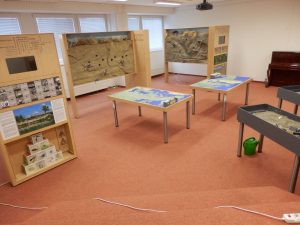
Výstava v MK v Petržalke
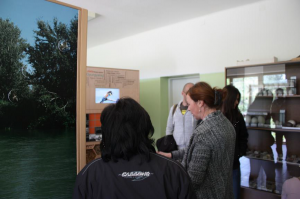
Výstava v Dropiom
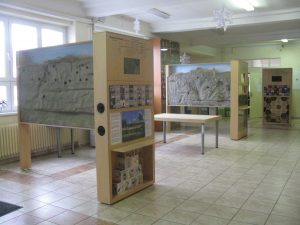
Výstava v Šuranoch
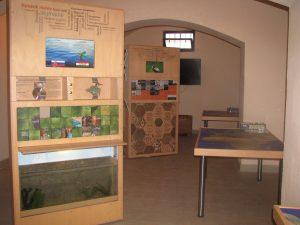
Výstava v Kollárove
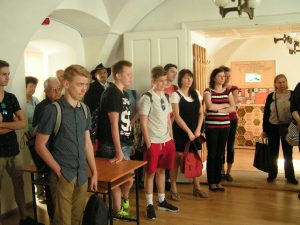
Výstava v Gyori
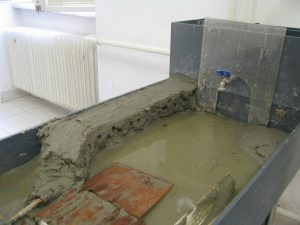
Výstava v Komárne

Výstava v Gbelcoch

Výstava v Piešťanoch

Výstava v Novej Dubnici

Výstava v Čadci

Výstava v Moravskom Svätom Jáne

Výstava vo Veľkom Léli
E.7: Presentations and excursions for schools and the public
Since the beginning of the project, we have conducted 76 events for 1799 participants: 15 student presentations with 478 participants, 21 student field trips with 620 participants, 15 public presentations with 422 participants, and 25 public field trips with 279 participants. During presentations and excursions we introduced the concerned bird species, project sites, project objectives, as well as the LIFE and Natura 2000 program.
The students and the public were very interested in the project activities, individual restoration measures, most of them expressed their support and appreciation for these activities.
25. 09. 2015 – Prezentácia pre študentov (BROZ)

20.06.2015 – Prezentácia pre verejnosť (BROZ)
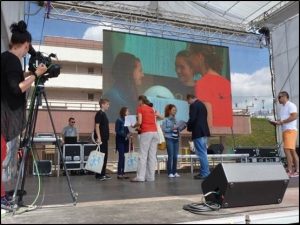
19.05.2015 – Prezentácia pre študentov (BROZ)

03.05.2015 – Exkurzia pre verejnosť (BROZ)
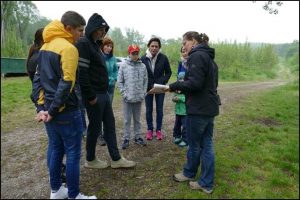
22.04.2015 – Prezentácia pre študentov (BROZ)
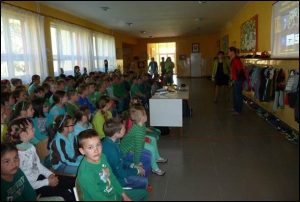



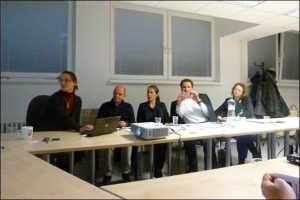
RNDr. Tomáš Kušík, PhD. – project manager
kusik(at)broz.sk
Brochure Včelárik a včely SK
Brochure A gyurgyalag és a méhek HU
Brochure The bee-eaters and the bees EN
Brochure Brehuľa hnedá SK
Brochure Partifecske HU
Brochure Sand Martin EN
Brochure Včelárik zlatý SK
Brochure Gyurgyalag HU
Brochure European Bee-Eater EN
Brochure Rybárik riečny SK
Brochure Jégmadár HU
Brochure Common Kingfisher EN

